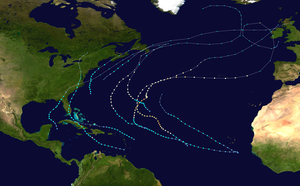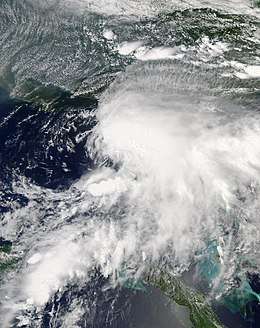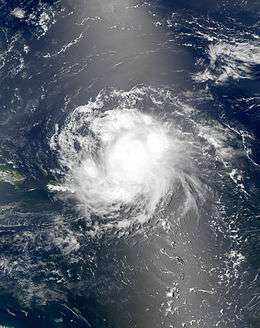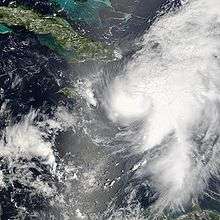Timeline of the 2006 Atlantic hurricane season
The 2006 Atlantic hurricane season was an event in the annual tropical cyclone season in the north Atlantic Ocean. Following the intense activity in the 2005 season, forecasts had initially predicted that the 2006 Atlantic hurricane season would be only slightly less active. However, activity was slowed by a rapidly forming El Niño event in 2006, the presence of the Saharan Air Layer over the tropical Atlantic, and the steady presence of a robust secondary high-pressure area to the Azores high centered on Bermuda.[1]

The season officially began on June 1, 2006, and lasted until November 30, 2006, dates that conventionally delimit the period of each year when most tropical cyclones develop in the Atlantic basin.[2] The first storm in the calendar year was Tropical Storm Zeta, which arose in December 2005 and persisted until early January 2006, only the second event on record that a storm spanned two calendar years in the Atlantic. The first in-season storm to form was Tropical Storm Alberto on June 10; the last, Hurricane Isaac (2006)|Hurricane Isaac]] became a tropical storm on September 28, and dissipated on October 2. Altogether, 10 named tropical storms developed in the Atlantic during the 2006 season, of which five became hurricanes with two intensifying further into major hurricanes.[nb 1] It was the first season since the 2001 season in which no hurricanes made landfall in the United States, and the first since the 1994 season that no tropical cyclones formed during October;[1]
This timeline documents all the storm formations, strengthening, weakening, landfalls, extratropical transitions, as well as dissipation. The timeline includes information which was not operationally released, meaning that information from post-storm reviews by the National Hurricane Center, such as information about a storm that was not operationally warned on,[nb 2] have been included.
Timeline of storms

January
- January 1
- January 6
- 2 a.m. AST (0600 UTC) – Tropical Storm Zeta weakens into a tropical depression.[4]
- 5 p.m. AST (2100 UTC) – Tropical Depression Zeta dissipates, finally ending the 2005 season.[4]
June

- June 1
- The 2006 Atlantic hurricane season officially begins.[5]
- June 10
- 1 a.m. CDT (0600 UTC) – Tropical Depression One forms 120 nautical miles (140 miles, 220 km) south of the western tip of Cuba.[6]
- 7 p.m. CDT (0000 UTC June 11) – Tropical Depression One strengthens into Tropical Storm Alberto.[6]
- June 13
- June 14
July
- July 17
- 0600 UTC – A previously extratropical low-pressure area becomes a tropical depression about 210 nautical miles (245 miles, 390 km) southeast of Nantucket, Massachusetts. However, this depression is not assigned a number operationally, or warned on, by the National Hurricane Center.[7]
- 1200 UTC – The tropical depression near Nantucket strengthens into a tropical storm, but is not operationally named.[7]
- July 18
- 8 a.m. EDT (1200 UTC) – Tropical Depression Two forms 250 nautical miles (290 miles, 645 km) east-southeast of Wilmington, North Carolina.[8]
- 1200 UTC – The unnamed tropical storm degenerates into a remnant low.[7]
- 2 p.m. EDT (1800 UTC) – Tropical Depression Two strengthens into Tropical Storm Beryl.[8]
- July 21
- 2:45 a.m. EDT (0645 UTC) – Tropical Storm Beryl makes landfall on the island of Nantucket, Massachusetts, with 50 mph (80 km/h) winds.[8]
- 2 p.m. EDT (1800 UTC) – Tropical Storm Beryl becomes extratropical.[8]
- July 31
August

- August 1
- 2 a.m. AST (0600 UTC) – Tropical Depression Three strengthens into Tropical Storm Chris.[9]
- August 3
- 2 p.m. AST (1800 UTC) – Tropical Storm Chris weakens to a tropical depression.[9]
- August 4
- August 21
- 2 p.m. AST (1800 UTC) – Tropical Depression Four forms 225 nautical miles (260 miles, 415 km) south-southeast of Praia, Cape Verde.[10]
- August 22
- 8 p.m. AST (0000 UTC August 23) – Tropical Depression Four strengthens into Tropical Storm Debby.[10]
- August 24
- 2 p.m. AST (1800 UTC) – Tropical Depression Five forms in the Caribbean Sea about 40 nautical miles (45 miles, 75 km) north-northwest of Grenada.[11]
- August 25
- 8 a.m. AST (1200 UTC) – Tropical Depression Five strengthens into Tropical Storm Ernesto.[11]
- August 26
- August 27
- 2 a.m EDT (0600 UTC) – Tropical Storm Ernesto strengthens into Hurricane Ernesto.[11]

- 8 a.m. EDT (1200 UTC) – Hurricane Ernesto weakens to a tropical storm.[11]
- August 28
- August 29
- 11 p.m. EDT (0300 UTC) – Tropical Storm Ernesto makes a second landfall at Plantation Key, Florida, with 45 mph (70 km/h) winds.[11]
- August 30
- 1 a.m. EDT (0500 UTC) – Tropical Storm Ernesto makes a third landfall in southwestern Miami-Dade County, Florida with 45 mph (70 km/h).[11]
- August 31
- 11:40 p.m. EDT (0340 UTC September 1) – Tropical Storm Ernesto makes a fourth landfall at Oak Island, North Carolina, with 70 mph (110 km/h).[11]
September
- September 1
- September 3
- 2 p.m. AST (1800 UTC) – Tropical Depression Six forms 855 nautical miles (990 miles, 1585 km) west of the Cape Verde Islands.[12]
- September 5
- 2 a.m. AST (0600 UTC) – Tropical Depression Six strengthens into Tropical Storm Florence.[12]
- September 10
- 2 a.m. AST (0600 UTC) – Tropical Storm Florence strengthens into Hurricane Florence.[12]
- 2 p.m. EDT (1800 UTC) – Tropical Depression Seven forms 470 nautical miles (545 miles, 870 km) east-northeast of the Leeward Islands.[13]
- September 11
- 8 a.m. EDT (1200 UTC) – Tropical Depression Seven strengthens into Tropical Storm Gordon.[13]
- September 12
- 8 a.m. EDT (1200 UTC) – Tropical Depression Eight forms 200 nautical miles (230 miles, 370 km) south-southeast of the Cape Verde Islands.[14]
- 8 p.m. AST (0000 UTC September 13) – Hurricane Florence becomes extratropical.[12]
- 8 p.m. EDT (0000 UTC September 13) – Tropical Storm Gordon strengthens into Hurricane Gordon.[13]
- September 13
- 2 p.m. EDT (1800 UTC) – Hurricane Gordon reaches Category 2 intensity.[13]
- 8 p.m. AST (0000 UTC September 14) – Hurricane Gordon reaches Category 3 intensity, becoming the first major hurricane of the season.[13]
- 8 p.m. AST (0000 UTC September 14) – Tropical Depression Eight strengthens into Tropical Storm Helene.[14]
- September 16
- 8 a.m. AST (1200 UTC) – Tropical Storm Helene strengthens into Hurricane Helene.[14]
- September 17
- 2 p.m. AST (1800 UTC) – Hurricane Helene reaches Category 2 intensity.[14]

- 8 p.m. AST (0000 UTC September 18) – Hurricane Helene reaches to Category 3 intensity, becoming the second major hurricane of the season.[14]
- September 20
- 8 p.m. AST (0000 UTC September 21) – Hurricane Gordon becomes extratropical.[13]
- September 24
- 2 p.m. AST (1800 UTC) – Hurricane Helene becomes extratropical.[14]
- September 27
- September 28
- 2 a.m. EDT (0600 UTC) – Tropical Depression Nine strengthens into Tropical Storm Isaac.[15]
- September 30
- 8 a.m. AST (1200 UTC) – Tropical Storm Isaac strengthens into Hurricane Isaac.[15]
October
November
- November 30
- The 2006 Atlantic hurricane season officially ends.[16]
See also
- Timeline of the 2006 Pacific hurricane season
- Timeline of the 2006 Pacific typhoon season
Notes
- Hurricanes reaching Category 3 (wind speeds of 111 miles per hour (179 km/h)) or higher on the 5-level Saffir–Simpson wind speed scale are considered major hurricanes.[3]
- To be warned on operationally means that storms were tracked at the time of their existence
- The figures for maximum sustained winds and position estimates are rounded to the nearest 5 units (knots, miles, or kilometers), following the convention used in the National Hurricane Center's operational products for each storm. All other units are rounded to the nearest digit.
References
- Mainelli; Bevan (2006-11-01). "Monthly Tropical Weather Summary for October 2006". National Hurricane Center. Retrieved 2006-11-01.
- Dorst, Neal (June 1, 2018). "Hurricane Season Information". Frequently Asked Questions About Hurricanes. Miami, Florida: NOAA Atlantic Oceanographic and Meteorological Laboratory. Retrieved June 29, 2020.
- "Saffir-Simpson Hurricane Wind Scale". Miami, Florida: National Hurricane Center. Retrieved June 29, 2020.
- Richard D. Knabb; Daniel P. Brown (2006-03-17). "Tropical Cyclone Report: Tropical Storm Zeta" (PDF). NOAA. Retrieved 2006-05-21.
- Atlantic Oceanographic and Meteorological Laboratory; Hurricane Research Division. "Frequently Asked Questions: When is hurricane season?". NOAA. Archived from the original on 2006-07-18. Retrieved 2008-08-21.
- Avila, Lixion A. and Brown, Daniel P./National Hurricane Center (2006-08-11). "Tropical Cyclone Report: Tropical Storm Alberto" (PDF). National Oceanic and Atmospheric Administration. Retrieved 2006-10-05.CS1 maint: multiple names: authors list (link)
- Blake, Eric S. and Beven, John L./National Hurricane Center (2006-12-15). "Tropical Cyclone Report: Unnamed Tropical Storm" (PDF). NOAA. Retrieved 2006-12-18.CS1 maint: multiple names: authors list (link)
- Pasch, Richard J./National Hurricane Center (2006-08-31). "Tropical Cyclone Report: Tropical Storm Beryl" (PDF). NOAA. Retrieved 2006-10-05.
- Stewart, Stacy R./National Hurricane Center (2006-11-29). "Tropical Cyclone Report: Tropical Storm Chris" (PDF). NOAA. Retrieved 2006-12-13.
- Franklin, James L./National Hurricane Center (2006-11-02). "Tropical Cyclone Report: Tropical Storm Debby" (PDF). National Oceanic and Atmospheric Administration. Archived from the original (PDF) on October 31, 2008. Retrieved 2006-11-22.
- Knabb, Richard D. and Mainelli, Michelle/National Hurricane Center (2006-12-15). "Tropical Cyclone Report: Hurricane Ernesto" (PDF). National Oceanic and Atmospheric Administration. Retrieved 2006-12-26.CS1 maint: multiple names: authors list (link)
- Beven, Jack/National Hurricane Center (2006-12-21). "Tropical Cyclone Report: Hurricane Florence" (PDF). National Oceanic and Atmospheric Administration. Retrieved 2007-01-05.
- Blake, Eric S./National Hurricane Center (2006-11-14). "Tropical Cyclone Report: Hurricane Gordon" (PDF). National Oceanic and Atmospheric Administration. Retrieved 2006-11-22.
- Brown, Daniel P./National Hurricane Center (2006-11-15). "Tropical Cyclone Report: Hurricane Helene" (PDF). National Oceanic and Atmospheric Administration. Retrieved 2006-11-22.
- Mainelli, Michelle/National Hurricane Center (2006-11-16). "Tropical Cyclone Report: Hurricane Isaac" (PDF). National Oceanic and Atmospheric Administration. Retrieved 2006-11-22.
- Neal Dorst (2007-06-01). "Subject: G1) When is hurricane season ?". National Oceanic and Atmospheric Administration. Archived from the original on 2006-07-18. Retrieved 2008-08-12.